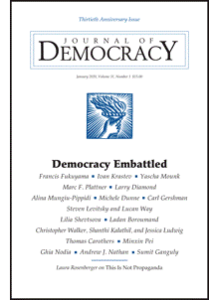
Democracies are dying at the hands of elected authoritarian populists who neuter or take over the institutions meant to constrain them, notes Stanford’s Larry Diamond. Yet mass prodemocracy protests in authoritarian and semiauthoritarian settings, from Armenia to Hong Kong to Sudan, underscore democracy’s continuing appeal, he writes for The Journal of Democracy.
 In repeated spasms of anti-government protests, Iranians have tended to focus on the venality of the regime in Tehran, and not the hostility of the government in Washington. Rather than address such grievances, the regime has responded with brute force, killing hundreds, Bobby Ghosh writes for Bloomberg (HT:FDD).
In repeated spasms of anti-government protests, Iranians have tended to focus on the venality of the regime in Tehran, and not the hostility of the government in Washington. Rather than address such grievances, the regime has responded with brute force, killing hundreds, Bobby Ghosh writes for Bloomberg (HT:FDD).
The Weatherhead Center for International Affairs at Harvard University has launched a new interactive map that catalogs all mass uprisings around the world between 1945 and 2014, The Harvard Gazette reports:
The map draws on data collected by Professor Erica Chenoweth and research fellow Christopher Shay that resoundingly showed that nonviolent campaigns achieve their political goals more effectively than violent campaigns. The findings upended the long-held assumption that only violent insurgencies can bring about large-scale political transformation…..The Nonviolent and Violent Campaigns and Outcomes (NAVCO) data project is the first of its kind to collect systematic data on both violent insurgencies and nonviolent civil resistance campaigns.
The coverage includes only maximalist campaigns, that is, movements seeking to overthrow an incumbent government, expel a foreign military occupation, or claim territorial independence, it adds.







